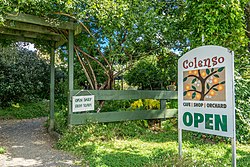Whenuakite
In this article, we will explore Whenuakite from different perspectives, with the aim of delving into its meaning, importance and applications. Likewise, we will analyze the implications that Whenuakite has in various contexts, whether in the personal, professional, social or cultural sphere. Through a multidisciplinary approach, we will address different aspects related to Whenuakite, with the purpose of offering a comprehensive and enriching vision on this topic. Through reflection, analysis and research, we aim to provide the reader with a broader and more detailed understanding of Whenuakite, allowing them to acquire relevant and useful knowledge for their personal and professional development.
Whenuakite | |
|---|---|
 Colenso Café on State Highway 25 near Whenuakite | |
 | |
| Coordinates: 36°54′44″S 175°46′19″E / 36.91222°S 175.77194°E | |
| Country | New Zealand |
| Region | Waikato |
| District | Thames-Coromandel District |
| Ward | Mercury Bay ward |
| Community Board | Mercury Bay Community |
| Electorates |
|
| Government | |
| • Council | Thames-Coromandel District Council |
| • Regional council | Waikato Regional Council |
| • Mayor of Thames-Coromandel | Len Salt[1] |
| • Coromandel MP | Scott Simpson[2] |
| • Hauraki-Waikato MP | Hana-Rawhiti Maipi-Clarke[3] |
| Postcode | 3591 |
Whenuakite is a locality on the Coromandel Peninsula of New Zealand. State Highway 25 runs through it. Whitianga is north west, Coroglen 8 km west, Cooks Beach and Hahei north, Hot Water Beach north east, and Tairua 18 km to the south east. The Whenuakite River flows from coastal hills in the east through the area to drain in the Whitianga Harbour.[4][5]
Demographics
Whenuakite is in the statistical area of Mercury Bay South, which also includes Coroglen and Hahei, but not Cooks Beach or Tairua. The statistical area covers 359.40 km2 (138.77 sq mi)[6] and had an estimated population of 1,470 as of June 2024,[7] with a population density of 4.1 people per km2.
| Year | Pop. | ±% p.a. |
|---|---|---|
| 2006 | 1,170 | — |
| 2013 | 1,092 | −0.98% |
| 2018 | 1,224 | +2.31% |
| 2023 | 1,437 | +3.26% |
| Source: [8][9] | ||

Mercury Bay South had a population of 1,437 in the 2023 New Zealand census, an increase of 213 people (17.4%) since the 2018 census, and an increase of 345 people (31.6%) since the 2013 census. There were 708 males and 726 females in 567 dwellings.[10] 1.9% of people identified as LGBTIQ+. The median age was 49.2 years (compared with 38.1 years nationally). There were 231 people (16.1%) aged under 15 years, 186 (12.9%) aged 15 to 29, 663 (46.1%) aged 30 to 64, and 360 (25.1%) aged 65 or older.[9]
People could identify as more than one ethnicity. The results were 94.4% European (Pākehā); 10.4% Māori; 1.0% Pasifika; 0.6% Asian; 1.0% Middle Eastern, Latin American and African New Zealanders (MELAA); and 2.3% other, which includes people giving their ethnicity as "New Zealander". English was spoken by 98.7%, Māori language by 2.7%, and other languages by 7.3%. No language could be spoken by 1.3% (e.g. too young to talk). The percentage of people born overseas was 18.8, compared with 28.8% nationally.[9]
Religious affiliations were 23.4% Christian, 0.4% Māori religious beliefs, 0.4% Buddhist, 0.6% New Age, and 1.5% other religions. People who answered that they had no religion were 66.2%, and 7.7% of people did not answer the census question.[9]
Of those at least 15 years old, 288 (23.9%) people had a bachelor's or higher degree, 651 (54.0%) had a post-high school certificate or diploma, and 279 (23.1%) people exclusively held high school qualifications. The median income was $34,700, compared with $41,500 nationally. 84 people (7.0%) earned over $100,000 compared to 12.1% nationally. The employment status of those at least 15 was that 540 (44.8%) people were employed full-time, 258 (21.4%) were part-time, and 21 (1.7%) were unemployed.[9]
Education
Whenuakite School is a coeducational full primary school (years 1–8) with a roll of 161 as of March 2025.[11][12] The school was founded in 1908.[13]
Notes
- ^ "2022 Elections Final Results", www.tcdc.govt.nz, Thames-Coromandel District Council, archived from the original on 10 February 2023, retrieved 27 February 2025
- ^ "Coromandel - Official Result". Electoral Commission. Retrieved 27 February 2025.
- ^ "Hauraki-Waikato – Official Result". New Zealand Electoral Commission. Retrieved 27 February 2025.
- ^ Peter Dowling, ed. (2004). Reed New Zealand Atlas. Reed Books. pp. map 16. ISBN 0-7900-0952-8.
- ^ Roger Smith, GeographX (2005). The Geographic Atlas of New Zealand. Robbie Burton. pp. map 41. ISBN 1-877333-20-4.
- ^ "Stats NZ Geographic Data Service". Statistical Area 2 2023 (generalised). Retrieved 27 February 2025.
- ^ "Aotearoa Data Explorer". Statistics New Zealand. Retrieved 26 October 2024.
- ^ "Statistical area 1 dataset for 2018 Census". Statistics New Zealand. March 2020. Mercury Bay South (167400). 2018 Census place summary: Mercury Bay South
- ^ a b c d e "Totals by topic for individuals, (RC, TALB, UR, SA3, SA2, Ward, Health), 2013, 2018, and 2023 Censuses". Stats NZ – Tatauranga Aotearoa – Aotearoa Data Explorer. Mercury Bay South (167400). Retrieved 3 October 2024.
- ^ "Totals by topic for dwellings, (RC, TALB, UR, SA3, SA2, Ward, Health), 2013, 2018, and 2023 Censuses". Stats NZ – Tatauranga Aotearoa – Aotearoa Data Explorer. Retrieved 3 October 2024.
- ^ "New Zealand Schools Directory". New Zealand Ministry of Education. Retrieved 1 March 2025.
- ^ Education Counts: Whenuakite School
- ^ "Whenuakite School Centennial Reunion". Eventfinder Limited. Archived from the original on 31 July 2012.